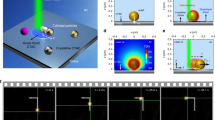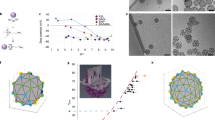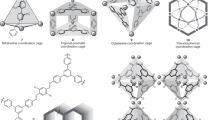Abstract
The chemical behaviour of molecules can be significantly modified by confinement to volumes comparable to the dimensions of the molecules. Although such confined spaces can be found in various nanostructured materials, such as zeolites, nanoporous organic frameworks and colloidal nanocrystal assemblies, the slow diffusion of molecules in and out of these materials has greatly hampered studying the effect of confinement on their physicochemical properties. Here, we show that this diffusion limitation can be overcome by reversibly creating and destroying confined environments by means of ultraviolet and visible light irradiation. We use colloidal nanocrystals functionalized with light-responsive ligands that readily self-assemble and trap various molecules from the surrounding bulk solution. Once trapped, these molecules can undergo chemical reactions with increased rates and with stereoselectivities significantly different from those in bulk solution. Illumination with visible light disassembles these nanoflasks, releasing the product in solution and thereby establishes a catalytic cycle. These dynamic nanoflasks can be useful for studying chemical reactivities in confined environments and for synthesizing molecules that are otherwise hard to achieve in bulk solution.
This is a preview of subscription content, access via your institution
Access options
Subscribe to this journal
Receive 12 print issues and online access
$259.00 per year
only $21.58 per issue
Buy this article
- Purchase on Springer Link
- Instant access to full article PDF
Prices may be subject to local taxes which are calculated during checkout




Similar content being viewed by others
References
Poole, L. B., Karplus, P. A. & Claiborne, A. Protein sulfenic acids in redox signaling. Annu. Rev. Pharmacol. Toxicol. 44, 325–347 (2004).
Tripp, B. C., Smith, K. & Ferry, J. G. Carbonic anhydrase: new insights for an ancient enzyme. J. Biol. Chem. 276, 48615–48618 (2001).
Forman, H. J. & Fridovic, I. Superoxide dismutase: a comparison of rate constants. Arch. Biochem. Biophys. 158, 396–400 (1973).
Hong, Y. J. & Tantillo, D. J. Consequences of conformational preorganization in sesquiterpene biosynthesis: theoretical studies on the formation of the bisabolene, curcumene, acoradiene, zizaene, cedrene, duprezianene, and sesquithuriferol sesquiterpenes. J. Am. Chem. Soc. 131, 7999–8015 (2009).
Yasumoto, T. & Murata, M. Marine toxins. Chem. Rev. 93, 1897–1909 (1993).
Nissen, P., Hansen, J., Ban, N., Moore, P. B. & Steitz, T. A. The structural basis of ribosome activity in peptide bond synthesis. Science 289, 920–930 (2000).
Faivre, D. & Schuler, D. Magnetotactic bacteria and magnetosomes. Chem. Rev. 108, 4875–4898 (2008).
Aizenberg, J., Tkachenko, A., Weiner, S., Addadi, L. & Hendler, G. Calcitic microlenses as part of the photoreceptor system in brittlestars. Nature 412, 819–822 (2001).
Li, X. Y. & Liu, D. R. DNA-templated organic synthesis: nature's strategy for controlling chemical reactivity applied to synthetic molecules. Angew. Chem. Int. Ed. 43, 4848–4870 (2004).
Kanan, M. W., Rozenman, M. M., Sakurai, K., Snyder, T. M. & Liu, D. R. Reaction discovery enabled by DNA-templated synthesis and in vitro selection. Nature 431, 545–549 (2004).
Mal, P., Breiner, B., Rissanen, K. & Nitschke, J. R. White phosphorus is air-stable within a self-assembled tetrahedral capsule. Science 324, 1697–1699 (2009).
Yoshizawa, M., Kusukawa, T., Fujita, M. & Yamaguchi, K. Ship-in-a-bottle synthesis of otherwise labile cyclic trimers of siloxanes in a self-assembled coordination cage. J. Am. Chem. Soc. 122, 6311–6312 (2000).
Yoshizawa, M., Tamura, M. & Fujita, M. Diels–Alder in aqueous molecular hosts: unusual regioselectivity and efficient catalysis. Science 312, 251–254 (2006).
Sastre, G. & Corma, A. The confinement effect in zeolites. J. Mol. Catal. A 305, 3–7 (2009).
Chu, Y. Y., Han, B., Zheng, A. M. & Deng, F. Influence of acid strength and confinement effect on the ethylene dimerization reaction over solid acid catalysts: a theoretical calculation study. J. Phys. Chem. C 116, 12687–12695 (2012).
Kundu, P. K., Olsen, G. L., Kiss, V. & Klajn, R. Nanoporous frameworks exhibiting multiple stimuli responsiveness. Nature Commun. 5, 3588 (2014).
Wei, Y.-S. et al. Coordination templated [2+2+2] cyclotrimerization in a porous coordination framework. Nature Commun. 6, 8348 (2015).
Fallah-Araghi, A. et al. Enhanced chemical synthesis at soft interfaces: a universal reaction–adsorption mechanism in microcompartments. Phys. Rev. Lett. 112, 028301 (2014).
Yang, D. Y. et al. Enhanced transcription and translation in clay hydrogel and implications for early life evolution. Sci. Rep. 3, 3165 (2013).
Komisarski, M., Osornio, Y. M., Siegel, J. S. & Landau, E. M. Tailored host–guest lipidic cubic phases: a protocell model exhibiting nucleic acid recognition. Chem. Eur. J. 19, 1262–1267 (2013).
Crosby, J. et al. Stabilization and enhanced reactivity of actinorhodin polyketide synthase minimal complex in polymer–nucleotide coacervate droplets. Chem. Commun. 48, 11832–11834 (2012).
Shevchenko, E. V., Talapin, D. V., Murray, C. B. & O'Brien, S. Structural characterization of self-assembled multifunctional binary nanoparticle superlattices. J. Am. Chem. Soc. 128, 3620–3637 (2006).
Macfarlane, R. J. et al. Nanoparticle superlattice engineering with DNA. Science 334, 204–208 (2011).
Sanchez-Iglesias, A. et al. Hydrophobic interactions modulate self-assembly of nanoparticles. ACS Nano 6, 11059–11065 (2012).
Nykypanchuk, D., Maye, M. M., van der Lelie, D. & Gang, O. DNA-guided crystallization of colloidal nanoparticles. Nature 451, 549–552 (2008).
Kalsin, A. M. et al. Electrostatic self-assembly of binary nanoparticle crystals with a diamond-like lattice. Science 312, 420–424 (2006).
Klajn, R., Wesson, P. J., Bishop, K. J. M. & Grzybowski, B. A. Writing self-erasing images using metastable nanoparticle ‘inks’. Angew. Chem. Int. Ed. 48, 7035–7039 (2009).
Lee, J.-W. & Klajn, R. Dual-responsive nanoparticles that aggregate under the simultaneous action of light and CO2 . Chem. Commun. 51, 2036–2039 (2015).
Das, S. et al. Dual-responsive nanoparticles and their self-assembly. Adv. Mater. 25, 422–426 (2013).
Chovnik, O., Balgley, R., Goldman, J. R. & Klajn, R. Dynamically self-assembling carriers enable guiding of diamagnetic particles by weak magnets. J. Am. Chem. Soc. 134, 19564–19567 (2012).
Manna, A. et al. Optimized photoisomerization on gold nanoparticles capped by unsymmetrical azobenzene disulfides. Chem. Mater. 15, 20–28 (2003).
Klajn, R., Bishop, K. J. M. & Grzybowski, B. A. Light-controlled self-assembly of reversible and irreversible nanoparticle suprastructures. Proc. Natl Acad. Sci. USA 104, 10305–10309 (2007).
Biedermann, F., Uzunova, V. D., Scherman, O. A., Nau, W. M. & De Simone, A. Release of high-energy water as an essential driving force for the high-affinity binding of cucurbit[n]urils. J. Am. Chem. Soc. 134, 15318–15323 (2012).
Biedermann, F., Vendruscolo, M., Scherman, O. A., De Simone, A. & Nau, W. M. Cucurbit[8]uril and blue-box: high-energy water release overwhelms electrostatic interactions. J. Am. Chem. Soc. 135, 14879–14888 (2013).
Biedermann, F., Nau, W. M. & Schneider, H.-J. The hydrophobic effect revisited—studies with supramolecular complexes imply high-energy water as a noncovalent driving force. Angew. Chem. Int. Ed. 53, 11158–11171 (2014).
Grego, A., Muller, A. & Weinstock, I. A. Stepwise-resolved thermodynamics of hydrophobic self-assembly. Angew. Chem. Int. Ed. 52, 8358–8362 (2013).
Heaven, M. W., Dass, A., White, P. S., Holt, K. M. & Murray, R. W. Crystal structure of the gold nanoparticle N(C8H17)4Au25(SCH2CH2Ph)18 . J. Am. Chem. Soc. 130, 3754–3755 (2008).
Zhu, M., Lanni, E., Garg, N., Bier, M. E. & Jin, R. Kinetically controlled, high-yield synthesis of Au25 clusters. J. Am. Chem. Soc. 130, 1138–1139 (2008).
Kondo, M., Takemoto, M., Matsuda, T., Fukae, R. & Kawatsuki, N. Photoinduced change in mechanical properties of anthracene polymers containing flexible side chains. Bull. Chem. Soc. Jpn 83, 1333–1337 (2010).
Xu, J. F., Chen, Y. Z., Wu, L. Z., Tung, C. H. & Yang, Q. Z. Dynamic covalent bond based on reversible photo 4+4 cycloaddition of anthracene for construction of double-dynamic polymers. Org. Lett. 15, 6148–6151 (2013).
Bouas-Laurent, H., Castellan, A., Desvergne, J. P. & Lapouyade, R. Photodimerization of anthracenes in fluid solution: structural aspects. Chem. Soc. Rev. 29, 43–55 (2000).
Jain, P. K., Huang, X. H., El-Sayed, I. H. & El-Sayed, M. A. Noble metals on the nanoscale: optical and photothermal properties and some applications in imaging, sensing, biology, and medicine. Acc. Chem. Res. 41, 1578–1586 (2008).
Harris, N., Ford, M. J. & Cortie, M. B. Optimization of plasmonic heating by gold nanospheres and nanoshells. J. Phys. Chem. B 110, 10701–10707 (2006).
Neumann, O. et al. Solar vapor generation enabled by nanoparticles. ACS Nano 7, 42–49 (2013).
Fox, M. A. & Olive, S. Photo-oxidation of anthracene on atmospheric particulate matter. Science 205, 582–583 (1979).
Alonso, R., Jimenez, M. C. & Miranda, M. A. Stereodifferentiation in the compartmentalized photooxidation of a protein-bound anthracene. Org. Lett. 13, 3860–3863 (2011).
Alonso, R., Yamaji, M., Jimenez, M. C. & Miranda, M. A. Enhanced photostability of the anthracene chromophore in aqueous medium upon protein encapsulation. J. Phys. Chem. B 114, 11363–11369 (2010).
Tung, C. H. & Guan, J. Q. Regioselectivity in the photocycloaddition of 9-substituted anthracenes incorporated within nafion membranes. J. Org. Chem. 63, 5857–5862 (1998).
Arumugam, S., Vutukuri, D. R., Thayumanavan, S. & Ramamurthy, V. A styrene based water soluble polymer as a reaction medium for photodimerization of aromatic hydrocarbons in water. J. Photochem. Photobiol. A 185, 168–171 (2007).
Acknowledgements
This work was supported by the European Research Council (grant no. 336080; R.K.), the NSF Division of Materials Research (grant no. 1309765; P.K.) and the American Chemical Society Petroleum Research Fund (grant no. 53062-ND6; P.K.). The authors thank R. Neumann and his group for the use of their gas chromatograph and T. Zdobinsky for technical assistance.
Author information
Authors and Affiliations
Contributions
R.K. conceived the project. H.Z., T.U., M.S., K.K., D.M., P.K.K. and J.-W.L. performed the experiments and analysed the data. P.K. and S.S. performed the computer simulations. R.K. wrote the paper.
Corresponding author
Ethics declarations
Competing interests
The authors declare no competing financial interests.
Supplementary information
Supplementary information
Supplementary information (PDF 5099 kb)
Rights and permissions
About this article
Cite this article
Zhao, H., Sen, S., Udayabhaskararao, T. et al. Reversible trapping and reaction acceleration within dynamically self-assembling nanoflasks. Nature Nanotech 11, 82–88 (2016). https://doi.org/10.1038/nnano.2015.256
Received:
Accepted:
Published:
Issue Date:
DOI: https://doi.org/10.1038/nnano.2015.256
This article is cited by
-
Photoswitchable gating of non-equilibrium enzymatic feedback in chemically communicating polymersome nanoreactors
Nature Chemistry (2023)
-
Enantiocontrolled macrocyclization by encapsulation of substrates in chiral capsules
Nature Synthesis (2023)
-
Mechanosensitive non-equilibrium supramolecular polymerization in closed chemical systems
Nature Communications (2023)
-
Hyper-CEST NMR of metal organic polyhedral cages reveals hidden diastereomers with diverse guest exchange kinetics
Nature Communications (2022)
-
Switchable aqueous catalytic systems for organic transformations
Communications Chemistry (2022)



